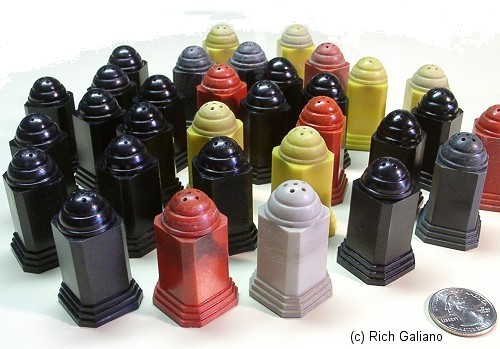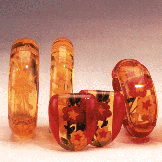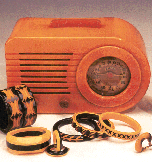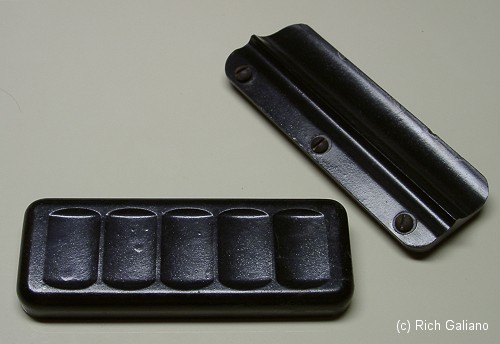Polymer Materials (2/3)
Early Plastics
Natural polymers with plastic-like properties have been used for centuries. These include shellac, tortoiseshell, and horn, as well as many resinous tree saps. Shellac is derived from insects; tortoiseshell is actually from sea turtles, primarily Hawksbills; while horn may be derived from any suitable animal, primarily cattle and sheep. Hard rubber Vulcanite and Gutta Percha were introduced in the 1840s. Bois Durci was developed in the 1850s from animal blood, a byproduct of Paris slaughterhouses. All of these materials could be processed with heat and pressure into articles such as hair combs and items of jewelry.
The first man-made plastic was an invention of English scientist Alexander Parkes. He unveiled Parkesine at the 1862 London International Exhibition. Parkesine, an organic material that could be heated and molded but would retain its shape when cooled, was made by dissolving cellulose nitrate in just a bit of solvent. Unlike rubber, Parkesine could be colored or transparent and could be carved into any shape. In 1866, four years after the exhibition, Parkes formed the Parkesine Company; it failed after only two years due to high production costs.

None of these materials was of any great industrial significance. The first really important man-made plastic, Celluloid, was discovered circa 1869 by the American inventor John W. Hyatt and manufactured by him in 1872. Celluloid is a transparent, colorless synthetic thermoplastic ( ie meltable and reshapeable ) made by treating cellulose nitrate ( nitrocellulose ) with camphor and alcohol. Celluloid was the first important synthetic plastic and was widely used as a substitute for more expensive substances, such as ivory, amber, horn, and tortoise-shell. Newark NJ was once a major center of celluloid production.
Celluloid is highly flammable and has been superseded by newer plastics with more desirable properties. It has been used for combs, brush handles, billiard balls ( although they had a tendency to explode ), knife handles, buttons, and other useful objects. Celluloid was also originally used for photographic and movie film. The inevitable breakdown of this natural plastic puts many old films and photos at risk, and most modern photographic films are based on synthetic cellulose acetate rather than celluloid. Surprisingly, celluloid is also edible, at least if you are a goat. It is still used to make ping-pong balls.
Synthetic plastics did not come into modern industrial use until the production of Bakelite in 1909 by the American chemist L.H. Baekeland. Bakelite, or polyoxybenzyl- methylenglycolanhydride, is a synthetic thermosetting (permanent) resin. Bakelite is a condensation polymer of formaldehyde and phenol. In practice, the phenol and formaldehyde are first polymerized to a small extent by using the proper choice of catalyst and temperature. The resulting prepolymer, called a resol, is a low-melting, soluble material, which can then be combined with a filler ( usually cotton linters or wood fibers ) and a pigment and heated under pressure in a mold to yield an object of the desired shape. The pure resin is colorless or amber-colored and very brittle; various fillers, pigments, and other additives are used to give it the desired properties depending on its application. The heating of the prepolymer results in extensive cross-links between the polymer chains, resulting in a tightly bound three-dimensional network.

Bakelite is tough, hard, dimensionally stable and strong, and highly resistant to heat, moisture, and most chemicals. It is easily machined and carved, as well as molded, and largely replaced celluloid after its introduction in the early 20th century. Bakelite has been widely used both alone, to form whole objects, and in combination with other materials, as a laminate or a surface coating. It was used as a substitute for hard rubber and amber as well as celluloid. Commercial uses of Bakelite included insulation for electrical apparatus ( since it is a nonconductor ) and the manufacture of certain machinery gears. It was also used for phonograph records and many other articles, useful and ornamental, and as diverse in character as buttons, billiard balls, pipestems, and umbrella handles. Bakelite distributor caps were fitted on Model-T Fords in the 1920s. During the Great Depression, Bakelite sold more than any other commercial product and was loved by the public for its brilliant and cheerful colors and its affordability. It found extensive use during World War II but was finally rendered obsolete soon after by newly developed materials like lucite, fiberglass, vinyl, and acrylics, although it is still produced in Japan.
Neither Celluloid nor Bakelite are used anymore. Celluloid deteriorates over time, but Bakelite is much more durable, and many old Bakelite objects, from telephones to radios to jewelry, are now sought-after as antiques. Pre-World War II shipwrecks such as the Mohawk can yield fine Bakelite artifacts which survive well in the water and are easily cleaned and conserved.
Bakelite: A Revolutionary Early Plastic
Text by Lloyd Fadem and Stephen Z. Fadem MD
Photographs by Doug Congdon-Martin

IT IS HARD TO BELIEVE that one can combine two unlikely substances like carbolic acid and formaldehyde to produce a beautiful and versatile substance such as phenolic resin or "Bakelite, " a revolutionary, non-flammable, early plastic. "The material of a thousand uses, " as it was called, made a splash in the 1920s, '30s and '40s.
Around the turn of the century, the Belgian-born scientist Dr. Leo Baekeland, working as an independent chemist, came upon the compound quite by accident. Anyone familiar with the newspaper printing business is aware of the Velox used as a proof; that was his first discovery. Velox was invented in 1899 and is still in use today. After selling the rights to this product to Eastman Kodak for three-quarters of a million dollars, he started developing a less flammable bowling alley floor shellac; bowling was becoming the latest rage in New York City. Dr. Baekeland soon realized that a resin that was both insoluable and infusible could have a much wider appeal when used as a molding compound. He obtained a patent and started the Bakelite Corporation around 1910.

Phenolic resin could be produced in a multitude of colors, commonly yellow, brown, butterscotch, green and red. Omitting the pigment could produce a transparent or translucent effect. The resin could be molded or cast, depending on variations in the formula. For molding, the formula was cooked until resinous, spread out in thin sheets to harden, then ground to a fine consistency. At this point, powdered fillers and pigment were added, to enable the resin to be molded and to add color. This mixture was then put through hot rollers which created large sheets of colored, hardened resin. These sheets were then ground into a very fine powder which was molded under high heat and pressure into the final product form. As a molded material the resin's drawback was the limited range of colors which could be created. For casting, the formula was modified slightly, enabling the resin to be poured into lead molds and then cured in ovens until it polymerized into a hard substance. The liquid resin could be tinted to any color or "marbelized" by mixing two colors together.
For the first ten years or so after its introduction, the resin was used primarily to make electrical and automobile insulators and heavy industrial products. Eventually, uses for the resin spread into the consumer market. Castings were made in the shape of cylinders or blocks and then sold to novelty and jewelry makers. Industrial designers began experimenting with the new material. Fine craftsmen sculpted the molded products on fast wheels with razor-like tools to carve out designs that the world has not seen since; after World War II, most companies switched to creating designs through the use of patterned molds, instead of hand-carving. Bakelite replaced flammable celluloid, previously the most popular synthetic material for molded items, as a major substance for jewelry production.
The process to the collector of today may not be significant, as Bakelite is now treasured for its unique, unreproducible beauty. A deeply carved half-inch bangle bracelet may sell for $225.00, and a two and one half inch bangle may command $900.00. Bakelite often acquires a patina within a few months to a few years of its date of production and metamorphosizes into a completely different appearing color. The red, white, and blue Bakelite designs of yesterday have mellowed into lovely yellows, reds, and blacks, enhancing further the value of those rare pieces which have continued to maintain their original color and luster.

Bakelite's many uses allowed it to become a standard item in the family home of the 1930s and 1940s. It was frequently found in the kitchen, in the form of flatware handles, rabbit or chicken napkin holders, salt and pepper shakers, or serving trays. During the Depression Bakelite sold more than any other commercial product and was loved by the public for its brilliant and cheerful colors and its affordability.
When the Bakelite patent expired in 1927, it was acquired by the Catalin Corporation that same year. They began mass production under the name "Catalin, " using the cast resin formula which enabled Catalin to add 15 new colors to the original five produced by the Bakelite Corporation, which used the limited color range molded formula, as well as the now-famous marbelized effect. One of their most notable products was the Fada bullet radio. The Catalin Corporation was responsible for nearly 70% of all phenolic resins that exist today.
Bakelite-Catalin was sold mostly by Saks Fifth Avenue, B. Altman and Bonwit Teller, but was also on the shelves of F.W. Woolworth and Sears. To the wealthy socialites, whose husbands had fallen on tough times during the Depression, with Tiffany diamonds and Cartier jewelry now well beyond their means, the vibrantly colorful carved jewelry adorned with rhinestones became de riguer for cocktail parties and formal dinners. Yet, Catalin and Bakelite were within everyone's reach with Depression prices ranging from twenty cents to three dollars. Diana Vreeland, the editor of Vogue, often spoke of the versatility of Bakelite, as did Elsa Schiaparelli, who was constantly contracting with the Bakelite and Catalin Corporations for exclusive buttons for her dress designs.
But in 1942 Bakelite and Catalin suspended sales of their colorful cylinders to costume jewelry manufacturers in order to concentrate on the wartime needs of a nation which had totally shifted its focus. Defense phones and aviator goggles, as well as thousands of other Bakelite products, found their way to armed forces around the world. The scheme shifted from the 200 vibrant colors which brightened the dark days of the Depression to basic black, the no-nonsense symbol of a nation at war. By the end of the war, new technology had given birth to injection-molded plastics, and most manufacturers switched to less labor-intensive and more practical means of developing products. The next generation of plastics had been born - lucite, fiberglass, vinyl, and acrylic - and they were molded into products commonplace in our everyday lives today.
Bakelite and Catalin became obsolete, but survive in the hearts of collectors who hunt flea markets, swap meets, and antique shows for the Depression treasures of a generation now consigned to the pages of history. Bakelite was given a boost in the mid-1970s by artist, photographer, and flea market icon Andy Warhol who fell in love with Bakelite carvings and whimsical Martha Sleeper pins, and amassed one of the largest collections.
Upon Warhol's untimely death in 1987, Bakelite reached the high prices which it ironically had never been able to command during its peak in the Depression. It is still quite possible and most exciting to discover that a deeply carved bracelet or a Martha Sleeper-designed pin purchased for $10.00 in a junk shop has a real value between $900.00 and $1,500.00!
In conclusion, Bakelite, an early plastic, represented an affordable solution for a unique and short time in history when a nation hinged on the edge of economic disaster and needed a cheerful substitute for the lost elegance of the 1920s. Now, while its usefulness as a practical product has long been replaced, Bakelite exists as a treasure. The prospective collector should acquire a sense and appreciation for Bakelite's true value, and a network of reliable dealers to purchase from.
Several books on the market are invaluable Bakelite aids to the new collector; they are identified below.
- The Best of Bakelite and Other Plastic Jewelry, by Dee Battle and Alayne Lasser ... $39.95 + $4 shipping from Deco Echoes
- Plastic Jewelry by Lyngerda Kelley and Nancy Schiffer ... $14.95 + $4 shipping from Deco Echoes
- Bakelite Jewelry by Tony Grasso ... $12.98 + $4 shipping from Deco Echoes
Lloyd Fadem is a well-known collector and mid-century enthusiast whose interest lies in architectural and industrial design of the thirties, forties and fifties. He is currently working on the book, "Cool Stuff." - Stephen Z. Fadem, M.D., is a prominent Houston nephrologist whose hobby is history, with a current fascination on the development of American technology and its impact upon our everyday lives. He is collaborating with his brother on the book "Cool Stuff."
Copyright 1996 Deco Echoes Publications
all rights reserved
Shipwrecks from after the turn of the century ( that's 1900, not 2000, kiddies ) to World War II can yield many fine artifacts in an early plastic material known as Bakelite. Bakelite actually has significant value to collectors as art and antiques. Bakelite artifacts are fun to find. They are generally colorful and need very little attention to restore to display condition. A little scrubbing with an old toothbrush and a weak acid solution or even vinegar will remove most stains and encrustation - no soaking or other bother required. You can even put them through the dishwasher. Then perhaps a little silicone spray or furniture polish to shine it up, and put it on the shelf. All plastics should be kept away from direct sunlight, as the UV degrades the material.

Nothing remarkable about these except for the fact that they are in near-perfect condition, not even discolored, while the chromed-steel trays themselves had completely dissolved in the seawater. Black Bakelite seems to be the toughest of all the varieties. The upper one is upside-down, showing the molded-in brass fasteners.

